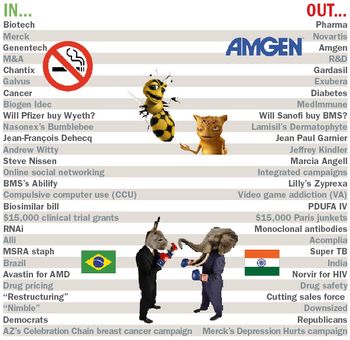
One of industry's main complaints is that delaying the introduction of new medicines is a particularly simple way of saving money

One of industry's main complaints is that delaying the introduction of new medicines is a particularly simple way of saving money

In August, eMarketer reported that Internet ad sales had officially displaced radio ad sales, nabbing the slot of fourth-largest ad medium. That was a huge blow to radio, which receives a sizable chunk of ad dollars from the pharma industry. Now pharma marketers have a new option-ReachMD, a 24-hour satellite radio station that plays content targeted at doctors.

The ultimate goal is for the medical system to develop new evidence as a natural by-product of delivering appropriate care

It's that time of year again, when Santas everywhere take stock of nice and naughty in order to fill stockings-and magazines make up their lists of hits and has-beens.

A crush of Phase III failures triggered an R&D turnaround at AstraZeneca


TKTKTKTKTKTK

Abbott Laboratories has received a positive opinion recommending approval of Humira (adalimumab) for the treatment of moderate to severe plaque psoriasis.






At the recent eyeforpharma Marketing ROI conference in Barcelona, one thing struck me forcefully: just how far behind the times the pharma industry is lagging.





Safety Risks, Generic Threat Scale Down Big Hopes

Bright Spots Are Emerging Markets, Specialty Drugs, Says IMS Health

HHS and Kaiser Family Foundation leverage phone texting technology to help people locate their nearest HIV/AIDS testing facility. Although slow to be adopted by the pharma industry, text marketing is becoming a useful tool to send health information directly to patients.


Cordis, the medical-device arm of J&J, took out full-page ads last week to publicize their drug-eluting stents.

Pfizer named first pharmaceutical sponsor of social-networking community custom tailored for physicians and healthcare providers. Sermo CEO Daniel Palestrant explains how the deal will work.

Novartis forced to cut 1,260 jobs due to dwindling pipeline, Zelnorm withdrawal. The company also adds new pharmaceutical division head.

The oncology market has experienced ten remarkable years. But is the 'Golden Age' coming to an end? IMS Health looks at the changing economics of the cancer industry in Pharm Exec Europe's new e-supplement.

In a blockbuster codevelopment deal, GlaxoSmithKline gains rights to an innovative Phase III melanoma drug.

June 2007 Sworn Statement

PharmRep Direct Promo